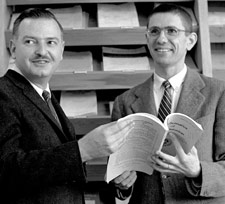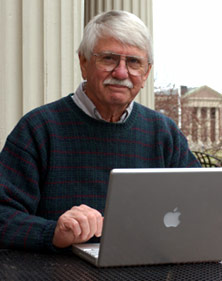Back to BASICs 40 years later
In the early hours of May 1, 1964, a quiet transaction at Dartmouth made computing history. It was on that day 40 years ago that two Dartmouth mathematics professors, John Kemeny and Thomas Kurtz, launched their BASIC computing language with the help of many industrious undergraduates.
Editorial Note: This article was originally published on the Dartmouth College website in 2004 to mark the 40th birthday of BASIC. It disappeared from their website in 2019 and permission was obtained to publish it here. Now BASIC is in its 60s!
1964 launch in a basement led to computer language's eventual widespread use
Two of these students, pulling an all-nighter while their professors slept, successfully ran two simple BASIC programs at about 4 a.m. on two separate Teletype terminals located in the basement of College Hall, which is now part of the Collis Center. BASIC (which stands for Beginners' All-purpose Symbolic Instruction Code) went on to be the most widely used computer language in the world, according to Kurtz, bringing computer technology to general audiences.
BASIC ran on the Dartmouth Time Sharing System (DTSS), a network of multiple simple terminals connected to a large computer, which was about a five-year-old idea at the time. DTSS became the early model for future large and more complex networks, and both BASIC and DTSS laid the groundwork for many of the computer applications we see today.
"BASIC and DTSS are inextricably linked," says Kurtz, Professor of Mathematics and Computer Science Emeritus. "You can't talk about one without the other. And it was our students, really, who did most of the work, with guidance of course from Kemeny and me. This wouldn't have happened without them."

John Kemeny (left) and Tom Kurtz in 1964. (Courtesy of the Dartmouth Library.)
In the late '50s and early '60s, Kurtz and Kemeny had a vision to create an environment where computers were welcoming to everyone, even to students pursuing nonscientific or math-related degrees. They also reasoned that their computer system should be readily available to students, with work areas in convenient places using a time-sharing system that was also easy to use. To achieve these goals, they developed their BASIC computer language, which was descended from FORTRAN and ALGOL, and implemented DTSS with help from many undergraduate student programmers. The group made plans to introduce BASIC as part of two fundamental math courses. Most Dartmouth students at the time took at least one of them.
"Lecturing about computing doesn't make any sense, any more than lecturing on how to drive a car makes sense. You just can't get the idea across," Kurtz said in a 1981 presentation to the Association for Computing Machinery. "So we decided that students had to write computer programs [as part of their courses]."
BASIC used simple, common-sense commands like LIST, SAVE, RUN, END and PRINT. According to Kurtz, BASIC was one of the world's most widely known computer languages thanks to grass-roots outreach efforts that brought the technology to a network of high schools, colleges and corporate partners. Variations of BASIC are still used today.
The vision of Kurtz and Kemeny continues, as Dartmouth still embraces the principle of providing modern computer and Internet resources to everyone, not just those majoring in computer science. Computing Services personnel regularly consult with and work with faculty members and students from around campus to implement new technology, like the campus-wide wireless network and the new convergence of phone, data and cable systems. Dartmouth's new Neukom Institute for Computational Science (see related) will carry on this legacy with a center dedicated to computational teaching, research and interdisciplinary study.

Tom Kurtz uses a laptop with a wireless network connection. (Photo by Joe Mehling '69.)
See Also
- The Computer and the Campus: An interview with John Kemeny
- BASIC at 50, BASIC Begins at Dartmouth
- The DTSS Time-Sharing System, Darmouth's original article of DTSS in the Wayback Machine.
- New 65C816 Kit, Back to BASIC
- For a full list of all the articles in Tek Eye see the full site alphabetical Index
Author:Susan Knapp Published:







